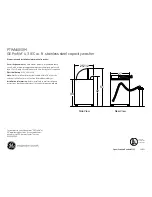
8
Loading the Silverware Basket
Load the silverware basket while it is in the bottom rack or take
the basket out for loading on a counter or table.
NOTE: Unload or remove the basket before unloading the racks
to avoid spilling water droplets on the silverware.
Mix items in each section of the basket with some pointing up
and some down to avoid nesting. Spray cannot reach nested
items.
IMPORTANT: Always load sharp items (knives, skewers, forks,
etc.) pointing down.
NOTES:
■
Do not load silver or silver-plated silverware with stainless
steel. These metals can be damaged by contact with each
other during washing.
■
Some foods (such as salt, vinegar, milk products, fruit juices,
etc.) can pit or corrode silverware. Run a rinse cycle if you do
not have a full load to wash immediately.
DISHWASHER USE
Detergent Dispenser
The detergent dispenser has 2 sections. The Pre-Wash section
empties detergent into the dishwasher when you close the door.
1. Cover
2. Main wash section
3. Cover latch
4. Pre-wash section
The Main Wash section automatically empties detergent into the
dishwasher during the main wash. (See the “Cycle Selection
Chart.”)
■
Use automatic dishwashing detergent only. Other detergents
can produce excessive suds that can overflow out of the
dishwasher and reduce washing performance.
■
Add detergent just before starting cycle.
■
Store tightly closed detergent in a cool, dry place. Fresh
automatic dishwasher detergent results in better cleaning.
NOTE: Do not use detergent with a rinse cycle.
Filling the dispenser
1. If the dispenser cover is closed, open the cover by pushing
the Cover latch.
2. Fill the Main Wash section with detergent. See “How Much
Detergent to Use.”
3. Close the Main Wash dispenser cover. Fill the Pre-Wash
section if needed.
NOTE: If you select the Normal cycle by turning the Cycle
Control knob before filling the dispenser, the detergent dispenser
cover will not stay latched. This is normal and will not affect
washing performance.
It is normal for the cover to open partially when dispensing
detergent.
NOTE: Use both sections for cycles with 2 washes. Use only the
covered section for cycles with 1 wash. See the “Cycle Selection
Chart” for more details.
How much detergent to use
■
The amount of detergent to use depends on the hardness of
your water and the type of detergent. If you use too little,
dishes won’t be clean. If you use too much in soft water,
glassware will etch.
■
Water hardness can change over a period of time. Find out
your water’s hardness by asking your local water department,
water softener company, or county extension agent.
■
Different brands of dishwasher detergent have different
amounts of phosphorous for softening water. If you have hard
water and use a detergent with a phosphorous content of less
than 8.7%, you might need to use more detergent, or use a
detergent with a phosphorous content higher than 8.7%.
1
2
3
4
Summary of Contents for TUD6000
Page 17: ...17 Notes ...
Page 35: ...35 Notes ...









































